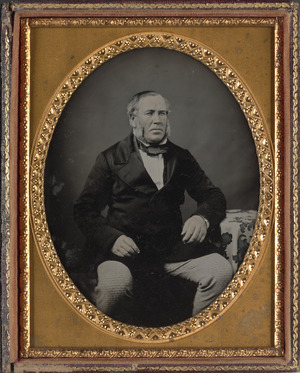Daniel Curdie facts for kids
Quick facts for kids
Doctor
Daniel Curdie
|
|
|---|---|

Portrait of Daniel Curdie ca. 1850-ca. 1870.
|
|
| Born | January 9, 1810 Slidderie, Arran, Scotland
|
| Died | February 22, 1884 (aged 74) |
| Scientific career | |
| Fields | Botany, algaeology. |
Daniel Curdie (1810-1884) was an important early pioneer in Australia. He was a doctor and helped found the town of Cobden in Victoria. He was also known for protecting the local Indigenous people and helping the farming industry grow in the Heytesbury area.
Contents
Early Life and Education
Daniel Curdie was born in 1810 in Slidderie, Arran, Scotland. He was the sixth son of Daniel MacCurdy and Mary McKinnon. He went to school in Ayr and earned his Master of Arts degree in Glasgow in 1832. Later, he studied in Edinburgh and became a doctor in 1838.
Journey to Australia and Settling Down
In 1839, Dr. Curdie sailed to Australia on a ship called the Caledonia. He arrived in Sydney on September 29, 1839. At that time, many people were excited about new lands being discovered in Australia, especially a fertile area called Australia Felix. This inspired Curdie and his nephew, Daniel McKinnon, to travel overland to the Port Phillip district (which is now Victoria).
Curdie left Melbourne with his animals and supplies and headed west. He found land south of Camperdown and set up his home there. He named his homestead "Tandarook." In the local Aboriginal language, "Tandarook" means a place where a special fungus called "native bread" (Laccocephalum mylittae) can be found. The Curdies River starts near his homestead and is named after him. In 1845, he explored the river all the way to its mouth and named that area Peterborough after his friend Peter Reid.
Curdie was so impressed by the beauty of another area that he called it Lovely Banks. However, when the town was officially planned in 1861, it had to be renamed. There was already a place called Lovely Banks near Geelong. So, they decided to name the town Cobden, after Richard Cobden (1804–65), a famous English politician who believed in free trade.
Doctor and Protector
For 11 years, Daniel Curdie worked as both a farmer (called a "squatter" in those days, meaning he settled on land) and a doctor. He was known for treating the local Indigenous people with kindness. They often came to Tandarook for safety during conflicts between different groups. Curdie was seen by many as a natural protector of the Indigenous community.
In 1851, he went back to Scotland to study botany, which is the study of plants. Three years later, he returned to Tandarook with his wife.
Botanist and Public Servant
Daniel Curdie was a very active farmer who also cared a lot about helping the community. After the Local Government Act was passed, he served on the Hampden Shire Council for several years. He also strongly supported building a rail line from Geelong to Warrnambool. He was also one of the people who helped start Geelong College, a well-known school.
Curdie often wrote letters to Ferdinand von Mueller, who was the Victorian Government Botanist. Mueller even visited "Tandarook" many times.
In 1872, Curdie was part of a government trip to Cape York to observe a total eclipse. This journey allowed him to study seaweeds, which was his favorite area of botany.
Daniel Curdie passed away on February 22, 1884. He left behind his wife and ten children. There is a monument honoring him in the main street of Camperdown.

